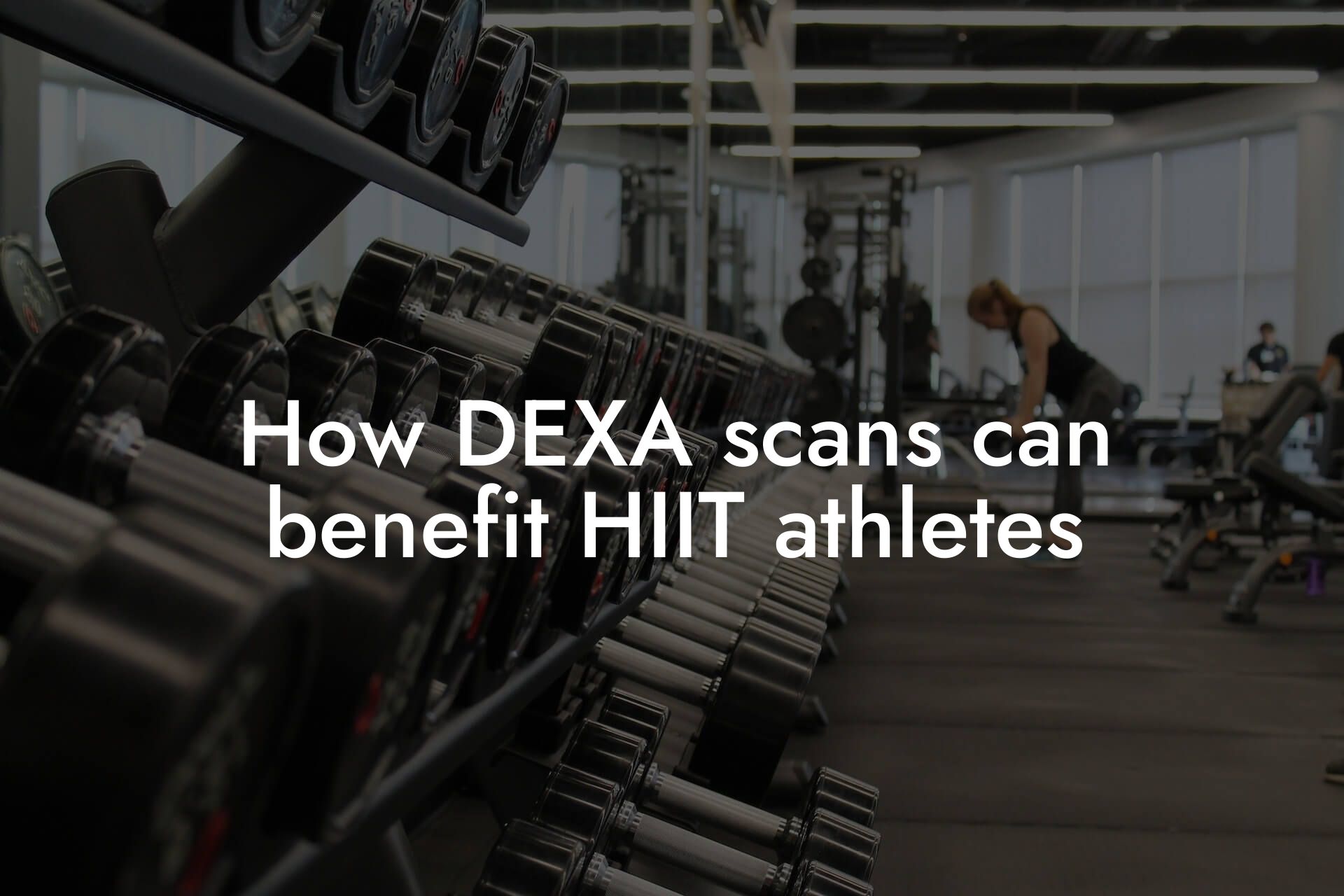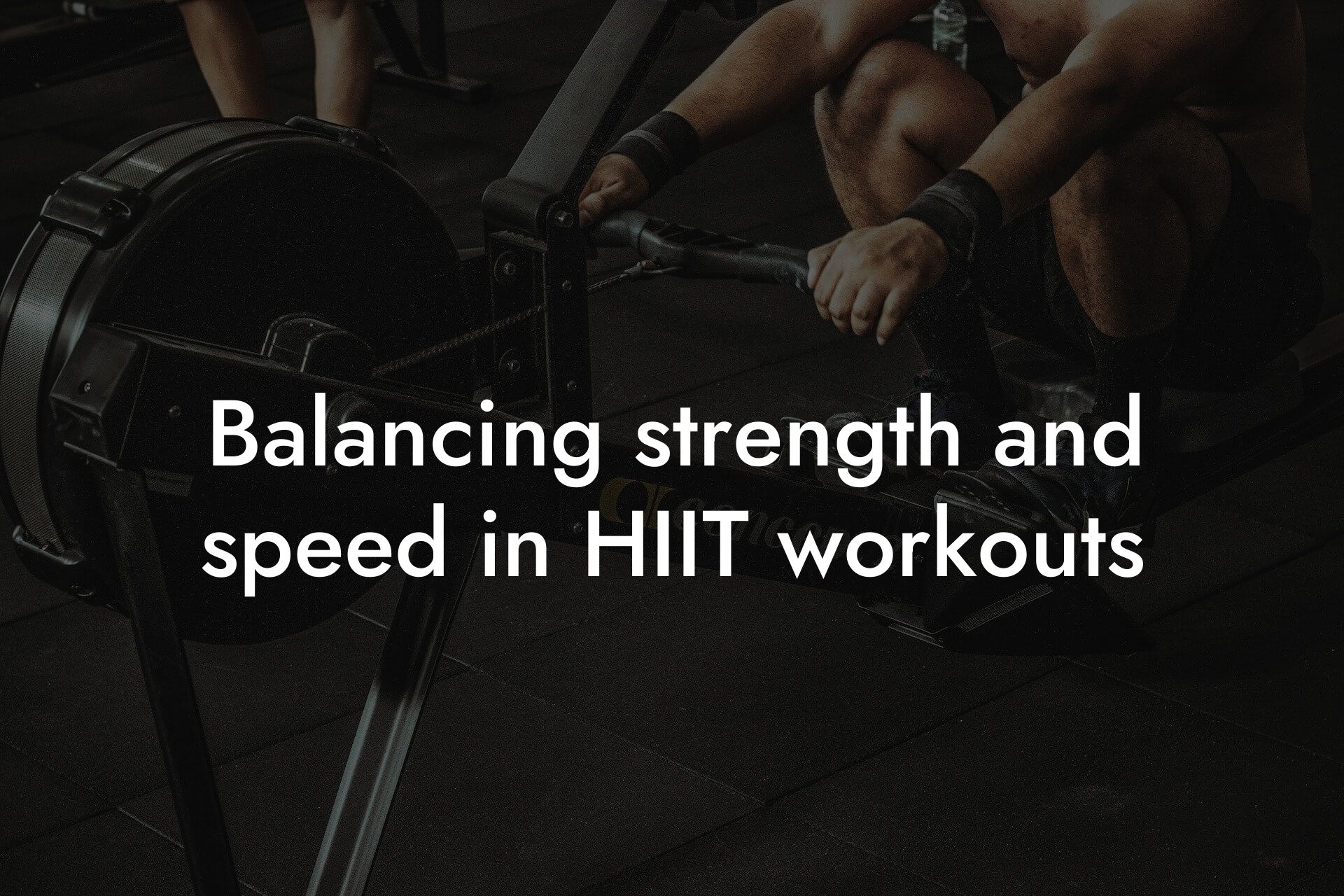As a high-earning professional, you understand the importance of maintaining a healthy and fit physique. With the demands of your busy schedule, it can be challenging to find the time and energy to prioritize your physical health. However, incorporating High-Intensity Interval Training (HIIT) into your fitness routine can be an effective way to improve your overall health and physique. But, it's equally important to prioritize muscle recovery to avoid injury and optimize your results. In this article, we'll explore the importance of muscle recovery with HIIT training and provide you with actionable tips to maintain muscle recovery and take your fitness to the next level.
Table of Contents
- What is HIIT Training?
- Why is Muscle Recovery Important with HIIT Training?
- The Importance of Rest and Recovery
- How to Incorporate Rest and Recovery into Your HIIT Routine
- Nutrition and Supplementation for Muscle Recovery
- Hydration and Electrolytes
- Monitoring Your Progress with DEXA Scans
- Frequently Asked Questions
What is HIIT Training?
HIIT training involves short bursts of high-intensity exercise followed by brief periods of rest or low-intensity exercise. This type of training has been shown to be effective in improving cardiovascular health, increasing caloric burn, and building lean muscle mass. HIIT workouts are typically shorter than traditional workouts, lasting anywhere from 15-30 minutes, making them an attractive option for busy professionals.
Why is Muscle Recovery Important with HIIT Training?
HIIT training can be intense and demanding on your muscles. When you engage in high-intensity exercise, you cause micro-tears in your muscle fibers. This can lead to muscle soreness, fatigue, and decreased performance if not properly addressed. Muscle recovery is essential to repair and rebuild your muscles, allowing you to perform at your best and avoid injury.
The Importance of Rest and Recovery
Rest and recovery are critical components of any exercise routine, including HIIT training. When you don't allow your muscles time to recover, you can experience decreased performance, increased muscle soreness, and a higher risk of injury. Adequate rest and recovery allow your muscles to repair and rebuild, making them stronger and more resilient.
How to Incorporate Rest and Recovery into Your HIIT Routine
Incorporating rest and recovery into your HIIT routine can be achieved through several strategies:
1. Active Recovery: Engage in low-intensity exercise such as yoga, stretching, or light cardio to promote blood flow and aid in the removal of waste products.
2. Passive Recovery: Avoid any strenuous activity and focus on relaxation techniques such as meditation, deep breathing, or reading.
3. Compression Garments: Wear compression clothing to improve blood flow and reduce muscle soreness.
4. Cold Therapy: Use cold water immersion, ice baths, or cryotherapy to reduce inflammation and promote recovery.
Nutrition and Supplementation for Muscle Recovery
Proper nutrition and supplementation play a critical role in muscle recovery. Consuming a balanced diet rich in protein, complex carbohydrates, and healthy fats provides your muscles with the necessary building blocks for repair and growth. Additionally, incorporating recovery-specific supplements such as protein powder, creatine, and branched-chain amino acids (BCAAs) can help promote muscle recovery and growth.
Hydration and Electrolytes
Adequate hydration is essential for muscle recovery. Water helps to flush out waste products, regulate body temperature, and transport nutrients to your muscles. Additionally, replenishing electrolytes such as sodium, potassium, and magnesium is critical to maintaining proper muscle function and preventing muscle cramps and spasms.
Monitoring Your Progress with DEXA Scans
As a high-earning professional, you understand the importance of tracking your progress and making data-driven decisions. At Tano Performance Group, we utilize DEXA scans to provide a comprehensive body assessment, including body fat percentage, lean muscle mass, and bone density. By regularly tracking your progress with DEXA scans, you can optimize your HIIT training and nutrition plan to achieve your fitness goals.
Maintaining muscle recovery with HIIT training is crucial to achieving optimal results and avoiding injury. By incorporating rest and recovery, proper nutrition and supplementation, hydration, and electrolyte replenishment, and regularly tracking your progress with DEXA scans, you can take your fitness to the next level and achieve the physique you desire. Remember, muscle recovery is not a luxury, it's a necessity. Prioritize your recovery and watch your body transform.
Frequently Asked Questions
What is HIIT training and how does it impact muscle recovery?
HIIT (High-Intensity Interval Training) is a type of workout that involves short bursts of high-intensity exercise followed by brief periods of rest or low-intensity exercise. This type of training can be beneficial for improving cardiovascular health, increasing caloric burn, and boosting metabolism. However, it can also be challenging for muscle recovery due to the intense nature of the exercise. Proper recovery strategies are essential to help your muscles repair and adapt to the demands of HIIT training.
Why is muscle recovery important for HIIT training?
Muscle recovery is crucial for HIIT training because it allows your muscles to repair and adapt to the intense exercise. During HIIT, your muscles experience micro-tears, which can lead to muscle soreness and fatigue. If you don't allow your muscles time to recover, you may experience decreased performance, increased risk of injury, and prolonged muscle soreness. Adequate recovery helps to promote muscle growth, improve performance, and reduce the risk of injury.
How can I optimize my muscle recovery after HIIT training?
To optimize muscle recovery after HIIT training, focus on proper nutrition, hydration, and rest. Consume a balanced meal or snack that includes protein and complex carbohydrates within 30-60 minutes after your workout. Stay hydrated by drinking plenty of water or a sports drink. Allow your body time to rest and recover, aiming for 1-2 rest days per week. Additionally, incorporate stretching, foam rolling, and self-myofascial release to help reduce muscle tension and promote recovery.
What role does nutrition play in muscle recovery after HIIT training?
Nutrition plays a critical role in muscle recovery after HIIT training. Consuming a balanced meal or snack that includes protein and complex carbohydrates helps to promote muscle repair and recovery. Protein provides the necessary building blocks for muscle repair, while complex carbohydrates help to replenish energy stores. Aim to consume 15-30 grams of protein and 20-30 grams of complex carbohydrates within 30-60 minutes after your workout.
How much protein do I need to consume after HIIT training?
The amount of protein you need to consume after HIIT training depends on your individual needs and goals. Aim to consume 15-30 grams of protein within 30-60 minutes after your workout. This can be achieved through a balanced meal or snack that includes protein-rich foods such as lean meats, fish, eggs, dairy, or plant-based options like legumes, nuts, and seeds.
What are some examples of protein-rich foods that can aid in muscle recovery?
Some examples of protein-rich foods that can aid in muscle recovery include lean meats like chicken, turkey, and beef, fish like salmon and tilapia, eggs, dairy products like milk and Greek yogurt, and plant-based options like legumes, nuts, and seeds. You can also consider protein supplements like whey protein or casein protein to help meet your protein needs.
How important is hydration in muscle recovery after HIIT training?
Hydration is crucial in muscle recovery after HIIT training. Adequate hydration helps to flush out waste products, reduce muscle soreness, and promote muscle recovery. Aim to drink at least 8-10 glasses of water per day, and consider a sports drink that contains electrolytes to help replenish lost salts and minerals.
What are some common mistakes people make when it comes to muscle recovery after HIIT training?
Some common mistakes people make when it comes to muscle recovery after HIIT training include not allowing enough time for rest and recovery, not consuming adequate nutrition, and not staying hydrated. Additionally, failing to incorporate stretching and foam rolling can lead to increased muscle tension and delayed recovery.
How can I reduce muscle soreness after HIIT training?
To reduce muscle soreness after HIIT training, try incorporating stretching, foam rolling, and self-myofascial release into your routine. These techniques can help to reduce muscle tension and promote blood flow to the affected areas. Additionally, consider taking a warm bath or using a topical cream or ointment that contains ingredients like arnica or capsaicin to help reduce muscle soreness.
What is the importance of rest and recovery in HIIT training?
Rest and recovery are essential components of HIIT training. During rest and recovery, your muscles have the opportunity to repair and adapt to the intense exercise. Adequate rest and recovery help to promote muscle growth, improve performance, and reduce the risk of injury. Aim to include 1-2 rest days per week and prioritize sleep to help your body recover.
How can I incorporate stretching into my HIIT training routine?
To incorporate stretching into your HIIT training routine, try adding 5-10 minutes of stretching exercises after your workout. Focus on stretching the major muscle groups, including your legs, hips, back, and shoulders. Hold each stretch for 15-30 seconds and breathe deeply, feeling the stretch in your muscles.
What are some benefits of incorporating foam rolling into my HIIT training routine?
Incorporating foam rolling into your HIIT training routine can help to reduce muscle soreness, improve circulation, and promote recovery. Foam rolling helps to break up adhesions and scar tissue in the muscles, allowing for improved blood flow and reduced muscle tension.
How can I use self-myofascial release to aid in muscle recovery?
Self-myofascial release involves using tools like lacrosse balls or tennis balls to release tension in the muscles. To use self-myofascial release, place the ball on the affected area and apply pressure, rolling the ball back and forth to release tension. This can help to reduce muscle soreness, improve circulation, and promote recovery.
What are some common injuries associated with HIIT training?
Some common injuries associated with HIIT training include muscle strains, tendonitis, and overuse injuries. These injuries can occur due to poor form, inadequate warm-up and cool-down, and insufficient recovery time. It's essential to prioritize proper form, warm-up and cool-down, and recovery to reduce the risk of injury.
How can I prevent injuries during HIIT training?
To prevent injuries during HIIT training, prioritize proper form, warm-up and cool-down, and recovery. Make sure to listen to your body and stop if you experience any pain or discomfort. Additionally, incorporate strength training exercises to help improve your overall strength and resilience.
What are some signs that I need to take a rest day?
Some signs that you need to take a rest day include persistent muscle soreness, fatigue, and decreased performance. If you're feeling exhausted, experiencing muscle soreness that lasts for several days, or noticing a decline in your performance, it may be time to take a rest day and allow your body to recover.
How can I incorporate HIIT training into my busy schedule?
To incorporate HIIT training into your busy schedule, try breaking up your workouts into shorter sessions, such as 10-15 minute intervals. You can also try incorporating HIIT training into your daily routine, such as taking the stairs instead of the elevator or doing a quick workout during your lunch break.
What are some benefits of incorporating HIIT training into my fitness routine?
Some benefits of incorporating HIIT training into your fitness routine include improved cardiovascular health, increased caloric burn, and boosted metabolism. HIIT training can also help to improve insulin sensitivity, reduce blood pressure, and increase muscle strength and endurance.
How can I track my progress with HIIT training?
To track your progress with HIIT training, try using a fitness tracker or wearable device to monitor your heart rate, distance, and calories burned. You can also track your workouts, including the exercises, sets, and reps you complete, to monitor your progress over time.
What are some common misconceptions about HIIT training?
Some common misconceptions about HIIT training include the idea that it's only for young, fit individuals or that it's too intense for beginners. However, HIIT training can be modified to suit individual fitness levels, and it can be an effective way to improve cardiovascular health and increase caloric burn for individuals of all ages and fitness levels.
How can I make HIIT training more enjoyable?
To make HIIT training more enjoyable, try incorporating music or podcasts into your workouts, working out with a friend or personal trainer, or trying new exercises and workouts to keep things interesting. You can also try rewarding yourself after a workout, such as with a post-workout smoothie or a relaxing bath.
Here are some related articles you might love...
- How DEXA scans can benefit HIIT athletes
- Balancing strength and speed in HIIT workouts
- Improving cardiovascular endurance with HIIT
- The role of body composition in HIIT performance
- The importance of bone density in HIIT fitness
- Strength training tips to enhance HIIT performance
- Reducing body fat for better HIIT workout results
- Preventing injuries during HIIT sessions
- Nutrition strategies for HIIT enthusiasts
Zak Faulkner
Zak Faulkner is a leading authority in the realm of physical health and body composition analysis, with over 15 years of experience helping professionals optimise their fitness and well-being. As one the experts behind Tano Performance Group, Zak has dedicated his career to providing in-depth, science-backed insights that empower clients to elevate their physical performance and overall health.
With extensive knowledge of DEXA technology, Zak specializes in delivering comprehensive body assessments that offer precise data on body fat, muscle mass, bone density, and overall physique. His expertise enables individuals to make informed decisions and achieve their fitness goals with accuracy and confidence. Zak’s approach is rooted in a deep understanding of human physiology, combined with a passion for helping clients unlock their full potential through personalised strategies.
Over the years, Zak has earned a reputation for his commitment to excellence, precision, and client-focused service. His guidance is trusted by top professionals who demand the best when it comes to their health. Whether advising on fitness programs, nutritional strategies, or long-term wellness plans, Zak Faulkner’s insights are a valuable resource for anyone serious about taking their health and fitness to the next level.
At Tano Performance Group, Zak continues to lead our Content Team revolutionising how professionals approach their physical health, offering unparalleled expertise that drives real results.




